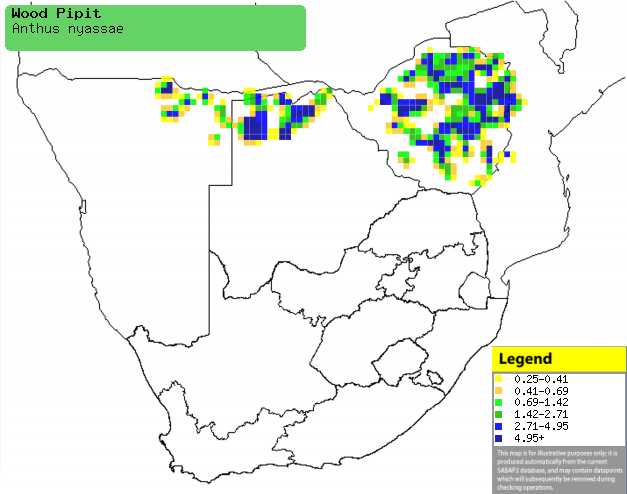|
Anthus nyassae (Wood pipit)
Boskoester [Afrikaans]; Miombokoester [Afrikaans];
Bospieper [Dutch]; Pipit à queue courte [French]; Miombopieper [German];
Petinha do Niassa [Portuguese]
Life
> Eukaryotes >
Opisthokonta
> Metazoa (animals) >
Bilateria >
Deuterostomia > Chordata >
Craniata > Vertebrata (vertebrates) > Gnathostomata (jawed
vertebrates) > Teleostomi (teleost fish) > Osteichthyes (bony fish) > Class:
Sarcopterygii (lobe-finned
fish) > Stegocephalia (terrestrial
vertebrates) > Tetrapoda
(four-legged vertebrates) > Reptiliomorpha > Amniota >
Reptilia (reptiles) >
Romeriida > Diapsida > Archosauromorpha > Archosauria >
Dinosauria
(dinosaurs) > Saurischia > Theropoda (bipedal predatory dinosaurs) >
Coelurosauria > Maniraptora > Aves
(birds) > Order: Passeriformes
> Family: Motacillidae > Genus: Anthus
Distribution and habitat
Occurs from the Congo through Angola, Zambia and Malawi to
southern Africa. Here it is locally fairly common across Zimbabwe, marginally
extending into Mozambique, with a separate population in north-eastern Namibia
and northern Botswana. It generally favours the grassy undergrowth of
broad-leaved woodland, especially Miombo (Brachystegia), Burkea (Burkea
africana), bloodwood (Pterocarpus) and Zambezi teak (Baikiaea
plurijuga) woodlands.
|
 |
|
Distribution of Wood pipit in southern Africa,
based on statistical smoothing of the records from first SA Bird Atlas
Project (©
Animal Demography unit, University of
Cape Town; smoothing by Birgit Erni and Francesca Little). Colours range
from dark blue (most common) through to yellow (least common). |
Food
It exclusively eats insects and other invertebrates, doing
most of its foraging in the undergrowth. The following food items have been recorded
in its diet:
Breeding
- The nest is an open cup with an extended rim on one side, made of root
stems and dry grass and lined with finer stems and rootlets. It is typically
placed in a hollow in the ground at the base of a grass tuft, well concealed
by overhanging vegetation.
- Egg-laying season is from July-February, peaking from
September-November.
- It lays 1-3, usually 2-3 faintly coloured eggs, covered in grey or brown
markings.
- Very little is known about the chicks. s
Threats
Not threatened.
References
-
Hockey PAR, Dean WRJ and Ryan PG 2005. Roberts
- Birds of southern Africa, VIIth ed. The Trustees of the John Voelcker
Bird Book Fund, Cape Town.
|
